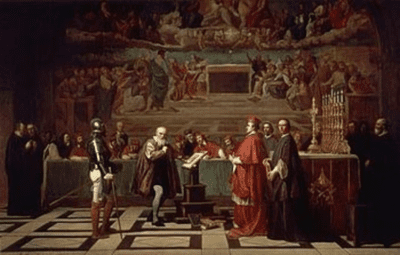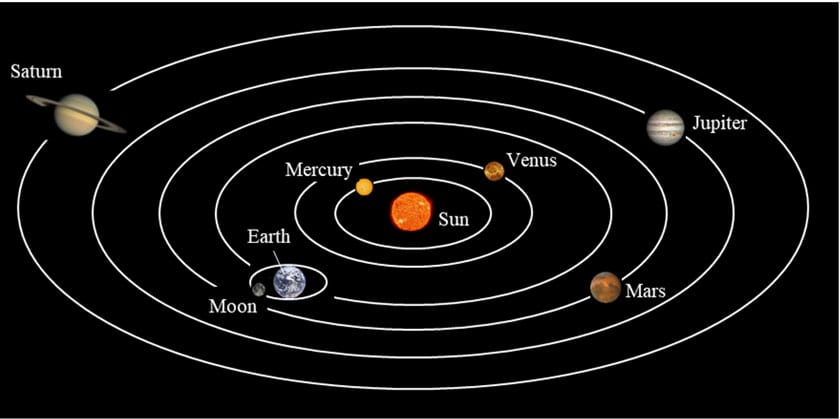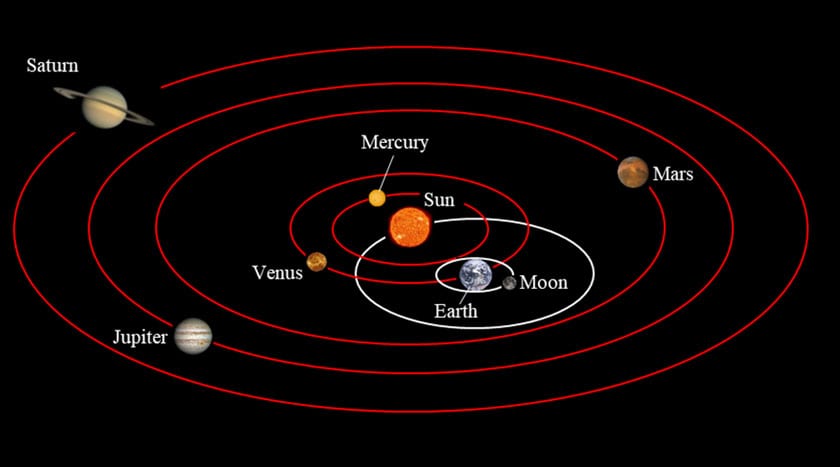Despite the considerable evidence that the Bible provided the necessary intellectual basis for science,1 atheists often claim that, historically, science and religion have been at war. For centuries, they say, the church opposed the advancement of science and human progress in general. When asked for evidence in support of this view, they usually cite the ‘Galileo affair’. Few, however, know what really happened, and many historians see the events of the time very differently to the caricatures often presented by the media.
Galileo Galilei (1564–1642) was one of the giants of early science. Although best-known for his work in astronomy, he was also an accomplished mathematician and made significant contributions to the understanding of motion, materials, and the development of the scientific method. Some have even described him as the ‘father of science’.
During the seventeenth century, there was much debate about the motions of the heavenly bodies and whether or not the earth was the center of the universe. Galileo believed that the earth moved around the sun and argued against the popular view that the sun moved around the earth. In 1633, the Roman Catholic Church forced him to renounce this view as heresy and imprisoned him for writing a play in which he argued in favor of it. Consequently, Galileo has often been portrayed as a martyr to progress, someone who was shamefully persecuted by an ignorant clergy simply because he attempted to further the advancement of science.
The reality, however, is quite different. At the time of Galileo’s trial, the scientific evidence did not support his assertion that the earth moves, and his ‘proof’ that it did was based on a flawed argument. It was only many years later that scientists were able to claim that he was right.2 Galileo was foolish and arrogant in the way he argued his case; he made enemies unnecessarily and threatened the establishment’s hold on the education system. Even at the time, many considered that he was the victim of politics rather than attempts to safeguard Christian doctrine.
The Copernican model, which put the sun at the center with the planets, including the earth, in orbit around it, is known as a ‘heliocentric and geokinetic model’—from Greek, hēlios (the sun) and kentron (centre); and, gē (the earth) and kinētikos (moving). Here, as well as orbiting the sun once per year, the earth spins, completing a full rotation every 24 hours. Copernicus argued that the spinning of the earth explains the apparent movements of the sun (and other heavenly bodies) around the earth over the course of the day and night. As with Ptolemy’s model, the planets’ orbital paths were circular but with added epicycles. Again, these were needed to make the theory fit with observations. This heliocentric model was favored by some mathematicians as a means of predicting the positions of the planets over time. In 1533, the Copernican theory was presented to Pope Clement VII who received it favorably and rewarded the presenter with a generous gift.3
Another model was proposed by Danish astronomer Tycho Brahe (1546–1601). As with the Ptolemaic system, the earth was stationary and central, with the sun, moon, and stars in orbit around it. However, the planets orbited the sun. (See fig. 4.) By the end of the sixteenth century, Brahe’s system had largely replaced Ptolemy’s as the preferred model.
With the help of an improved telescope he built in 1609, Galileo became convinced that Copernicus was correct and argued that we could be sure that the earth was in motion because of the oceanic tides. The spinning of the earth, he said, along with its orbiting of the sun, caused the water to ebb and flow over the earth’s surface. While some Roman Catholic astronomers were favorable to the Copernican system, others, including most of the leading scientists of the day, felt that Galileo’s insistence on the ‘fact’ of the Copernican system went well beyond the evidence. If the earth spun, they asked, why didn’t everything fly off it, as water flies off the rim of a spinning wheel? Also, why were there not fierce winds? A pressing problem with heliocentric models was that they predicted that small changes in the positions of stars would be visible over the course of the year. This is known as ‘stellar parallax.’
Cristoforo Grienberger, one of the Church’s most respected astronomers, argued that Galileo would do better to produce more convincing proofs before seeking to ‘adjust’ Scripture to fit with his theory.4 Indeed, for many, the failure to observe changes in the positions of the stars strongly favored Brahe’s model.5
Cardinal Robert Bellarmine was arguably the most respected Roman Catholic theologian of the time, and was also knowledgeable about astronomy. In a letter written in 1615, he acknowledged that, if it could be demonstrated that the earth orbits the sun, it would be necessary to reconsider how the scriptures should be interpreted in this matter. However, he also made clear that no such demonstration had been given to him. He wrote:
“… if there were a real proof that the sun is in the center of the universe … and that the sun does not go round the earth but the earth round the sun, then we should have to proceed with great circumspection in explaining the passages of Scripture which appear to teach the contrary, and we should rather have to say that we did not understand them … But I do not think there is any such proof since none has been shown to me.”6
Galileo had not presented this proof because he didn’t have it. Instead, he bluffed, ridiculed his opponents and, in remarkable arrogance, claimed that the problem lay in their inability to follow his arguments.7 He became impatient and, early in 1616, sought to convince the pope (that is Pope Paul V), presenting the oceanic tides as ‘proof’ that the earth is not stationary. The pope responded by summoning his advisors8 whom he asked to consider the matter. Under pressure to provide an answer, they responded quickly. Their conclusion was that Galileo’s belief that the sun is stationary was contrary to Scripture and heretical, and that his view that the earth is not stationary was an error.
In response, the pope directed that Cardinal Bellarmine urge Galileo to abandon his opinion and, if he refused, be commanded before witnesses, under threat of imprisonment, to refrain from teaching, defending, or even discussing it. Galileo agreed to abide by the ruling. In addition, on 5 March 1616, it was decreed9 that Copernicus’s theory was “false and contrary to Holy Scripture”. The decree, however, stopped short of condemning it as heretical. Moreover, Copernicus’s book was not to be “prohibited and condemned”, because it was felt that, with amendment, it would present the heliocentric theory only as a ‘mathematical hypothesis’, rather than something true and reconcilable with Scripture. Indeed, as a means of performing calculations, and producing calendars and star charts, it was considered useful. Hence, it was only to be “suspended until corrected”.
Although approved by the pope, these rulings were not endorsed in such a way as to make them unchangeable—and deliberately so.10,11,12 Hence, the pronouncement against the Copernican system could, in theory, be reversed at some point in the future. Moreover, the requirement for Galileo to “abandon his opinion” should be understood in the context of a written statement, by Cardinal Bellarmine himself, to the effect that Galileo had not been forced to renounce his view.13,14 Although Roman Catholic astronomers were required to conform outwardly, there was no absolute prohibition on their inward thoughts on the matter.15 Nor were they prohibited from discussing it quietly among themselves.16
Some have maintained that the Roman Catholic Church’s ruling on this matter was based primarily on religious considerations. Others, however, doubt this. For many academics of the day, the suggestion that the earth was not stationary seemed a radical and even dangerous idea, a departure from common sense and the perceived wisdom held almost universally by the esteemed scholars of the past. And as pointed out above, it conflicted some of the best science of their day. It threatened to overthrow the very foundations of medieval astronomy and discredit Aristotle, the revered philosopher whose writings had been the basis of what had been taught in the universities for centuries. According to Professor Giorgio de Santillana, it was chiefly these professors, rather than churchmen, who were behind the prohibition of Copernicanism in 1616.17
In 1623, a friend of Galileo became pope—Pope Urban VIII. Urban had supported Galileo in 1616 and had opposed the view that his teaching was heretical. Had it been in Urban’s power, the prohibition against the Copernican theory would not have been passed.18 Moreover, as pope, he had confided to a colleague that, in his understanding, the church had neither condemned nor would condemn the doctrine of Copernicus as heretical, but only “rash”.19 Hence, he was happy for Galileo to argue in favor of the model, so long as he presented it only as a hypothesis—albeit one that explained the observations very well. He could not, however, assert that it was true, as God, he said, being all-powerful, could have produced the observable effects in some other way.
Greatly encouraged, Galileo set about writing a play20 in which the arguments for and against the geocentric and heliocentric systems were to be discussed. As a literary work, it was brilliant—witty, majestic, and composed of breath-taking language. As a scientific treatise, however, it fell far short of what might be expected from a man of Galileo’s abilities.21 For example:
- It misrepresented the Copernican model making it appear much simpler than it is. With its need for epicycles, Copernicus’s model was arguably as complicated as Ptolemy’s.
- It failed to give due consideration to Tycho Brahe’s model, the one favored by many astronomers of the day.
- It argued that the tides arose due to the motion of the earth and failed to engage seriously with the alternative view that they were the result of the influence of the moon.
According to Albert Einstein, had Galileo not been so passionate in his quest to convince people of the Copernican model, and had someone else presented the tides as evidence for the earth’s motion, Galileo himself would have been among the chief sceptics. Einstein wrote:
“It was Galileo’s longing for a mechanical proof of the motion of the earth which misled him into formulating a wrong theory of the tides. The fascinating arguments in the last conversation [in the play] would hardly have been accepted as proofs by Galileo, had his temperament not got the better of him.”22
The play was finished in 1630 and printing was completed in 1632. It did not, however, present the Copernican system as just a hypothesis, and was soon to incur the wrath of Galileo’s enemies. Many in the church hierarchy were devoted Aristotelians, having embraced much of his philosophy and science. They believed that they had ‘Christianized’ his formidable logic and now used it in defense of the Roman Catholic faith, and as the basis for teaching in their universities. Moreover, in Galileo’s play, Aristotelians were ridiculed, and their defender portrayed as a simpleton named “Simplicio”. Those who did not share the Copernican view were described as “mental pygmies”, “dumb idiots” and “hardly deserving to be called human beings”.23
This kind of folly and arrogance was not untypical of Galileo. In a private note he wrote of himself that “it was granted to me alone to discover all the new phenomena in the sky and nothing to anybody else. This is the truth which neither malice nor envy can suppress.” Similarly, in his play, he claimed to be the original discoverer of the solar spots and “all other novelties in the skies”.24 Arthur Koestler wrote of Galileo’s approach to debate:
“His method was to make a laughing stock of his opponent in which he invariably succeeded, whether he happened to be in the right or in the wrong. … It was an excellent method to score a moment’s triumph, and make a lifelong enemy.”25
The Aristotelian professors pointed out to the pope that his favorite argument—that Copernicanism could not be proven because God could produce the observed effects by numerous different means—had been put into the mouth of Simplicio, the man who, on every other point, had been proved wrong. Moreover, they persuaded him that Simplicio had been intended to be a caricature of his own person. The pope, a proud and vain man, was enraged, not only by this, but because he felt betrayed by Galileo’s failure to abide by his instruction that the play should present the Copernican model only as a hypothesis. Feeling that he had been deceived, the pope ordered that Galileo be brought to trial by the Inquisition.
The trial
In 1616, Cardinal Bellarmine had been instructed to warn Galileo to abandon the Copernican theory and, if he refused, be commanded before witnesses, under threat of imprisonment, to refrain from teaching, defending, or even discussing it. A church document, dated 3 March 1616, records that Galileo acquiesced, suggesting that he was never actually prohibited from discussing it.26 Cardinal Bellarmine’s note, testifying that Galileo had not been forced to renounce his view, would seem to support this interpretation. However, at the trial, another document was produced indicating that the prohibition not even to discuss it had actually been given. This stated that Galileo had been commanded not “to hold, teach or defend it in any way whatsoever, verbally or in writing.” The validity of this latter document, however, has been the subject of much discussion. The usual signatures are missing and the witnesses were servants who had no knowledge of the procedures.27 While some historians think that the document was genuine,28 others have suggested that it was a deliberate forgery by Galileo’s enemies;29 still others believe that the record had simply been written in error.30 Galileo himself denied all knowledge of this prohibition.31,32
Despite its questionable nature, the document stating that Galileo had been commanded not to defend Copernicanism “in any way whatsoever” was accepted by the Inquisition. Moreover, it was asserted that the heliocentric view was contrary to Scripture and heretical. Galileo, they concluded, had disobeyed the command not even to discuss the Copernican theory, and had rendered himself “suspected of heresy”. In order to avoid further charges, Galileo was forced on oath to renounce the heliocentric view as heretical and false. In addition, he was sentenced to imprisonment, albeit an ‘incarceration’ which was merciful by any standard. Firstly, he was confined in the Grand Duke’s villa and secondly in a palace in Sienna where he worked “in an apartment covered in silk and mostly richly furnished”.33 Thereafter he remained under house arrest until his death.
Many at the time questioned the justice of the verdict and sentence. The view that the heliocentric theory was heretical was not one that was held completely universal within the church. Cardinals Bellarmarine and Conti, for example, had both agreed that Scripture might legitimately be interpreted differently, allowing for a moving Earth, but only IF science showed conclusively that the heliocentric model was correct.6,34 One archbishop is on record as stating that “Galileo was the greatest man of the age, that his condemnation was unjust, [and] that the Inquisition should not have ruled on a question of science”.35 Even the pope himself had previously described Copernicus’s theory only as “rash”. According to Professor Klaus Fischer, “That the whole trial was questionable could not be hidden to insiders. There was much resistance by high Church officials”.36 Moreover, by the end of the century, the Copernican theory was being freely taught by Roman Catholic astronomers.37
Conclusion
At the time of Galileo’s trial, the scientific evidence favored a geostatic model. Galileo was wrong in asserting that the Copernican system was correct. The Roman Catholic Church at the time had every reason to doubt Galileo’s assertions, and the pope had every reason to insist that Galileo present Copernicus’s theory only as a hypothesis. Galileo lacked humility and was foolish in the way he argued his case. He made claims that he could not substantiate and mocked those who held different views. He antagonized his opponents and invited their hostility. Galileo’s trial is not an example of religion opposing science. Rather, it is a tale of human pride and the protection of self-interest.
Source: https://creation.com/galileo-church
Galileo wrote that Pythagoras believed that the planets orbit the Sun. Newton credited Pythagoras for having discovered the inverse square law of gravity. Nowadays, science textbooks credit Pythagoras with the theory that Earth moves, and some expert historians claim that Pythagoras proved the Pythagorean theorem. Yet there is no evidence for any of these claims. Why do such fictions propagate? Is the truth that difficult to find or say? An unconscious yearning for ambiguity and fiction infects some parts of history. What happens if we remove such fictions? I will show how stories about Pythagoras played a dangerous role in the Inquisition trials of Giordano Bruno and Galileo. I will also comment on how some historians in the late 1900s increasingly echoed aspects of subjectivism, cultural relativism, and postmodernism to inadvertently propagate careless mistakes, as if the past were blurry, unstable, and subjective. Alberto A. Martínez is Professor of History of Science at the University of Texas at Austin and the author of six books, including The Cult of Pythagoras: Math and Myths (2012), and Burned Alive: Giordano Bruno, Galileo, and the Inquisition (2018). His work has appeared in Annals of Science, American Journal of Physics, Scientific American, Physics World, the Big Picture Science program of SETI, the Peabody Award winning show Radiolab, and other platforms.





